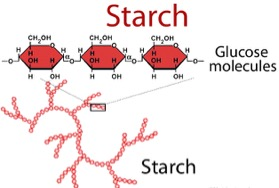It is possible to classify the polymers based on their origin, either synthetic or natural. There are numerous polymers which are having different behaviors. The first classification of the polymers is based on their source of origin. The natural polymers are naturally occurring in nature or they are existing in the natural sources like animals, and plants. Proteins are the common examples of the natural polymers which are commonly found in the animals and humans. Starch and cellulose that are found in the plants and the rubber that is harvested from the latex of the tropical plant are also natural polymers.
Starch
It is an important natural polymer that is responsible for making the food reserves for all of the plants. D- glucose is the monomer of the starch. Hundreds of D glucose molecules join through the glycosidic linkage when a polymer of starch is produced. Mainly, the starch is produced by the plants to store the energy. Plants synthesize the starch out of the natural glucose.

Starch is much similar to that of cellulose but the cellulose is a fiber that cannot be digested. The units of glucose are present around the other glucose units in the starch polymer and it works just like the wall of the water. So, due to this reason, plants do not need too much water. Eating of the starchy foods causes the breakdown of the glucose and energy is provided to our body. Except for the plants, no other organisms can make the starch.
Proteins
For the life of animals, and humans, the proteins are the building blocks. Simply they are polypeptides and are formed by the polymerization of amino acids. The structure of these proteins can be cross-linked or long chains. Hundreds of molecules of the amino acid are linked together to make the protein molecule and their arrangement is even highly organized and among the natural polymers, proteins are far versatile. A protein is a polyamide, so the proteins are the polymers of the amino acids and each amino acid has an acid end and an amino end. The shape and function of protein are greatly determined by the order of the R group. This R group can be small like the hydrogen or can be too big. Proteins occur naturally and they are made by the fungi, plants, bugs, animals, and the other living things including human beings.